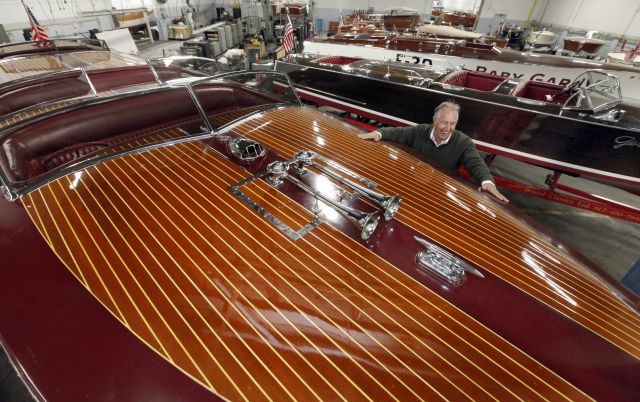By Kristin Tillotson, Star Tribune
Todd Warner has spent nearly four decades finding and restoring more than 100 historic wooden boats. Next weekend, his beauties go on the auction block, and he hopes some of them stay in Minnesota.
To modern-boat enthusiasts, the cavernous warehouse in tiny Winsted, Minn., might look like it’s filled with 40-foot-long dinosaurs. Sleek, swift, gorgeous dinosaurs, maybe, but creatures that belong in the past.
To Todd Warner, owner of the largest private collection of vintage wooden boats in the country, they are objects of unparalleled beauty, timeless enjoyment and rich history.
Warner has spent 37 years collecting and restoring more than 125 boats, from custom-made power racers and runabouts worth hundreds of thousands of dollars to beat-up rowboats and canoes worth the sweat equity needed to restore them.
Next Saturday, he’ll be kissing many of the fruits of his life’s passion goodbye. His beloved Chris-Crafts and Hackercrafts, runabouts and launches, boats with names like Thunderballs, the Gerry Lo and the Sugar Lady are being auctioned to raise capital to restructure his business, Mahogany Bay.
“Boats are time capsules for storytelling from generation to generation,” Warner said. “It’s taken me 37 years to find them all, and in eight hours, they’ll be scattered to the wind. I hope some stay in Minnesota.”
The collection includes showoffs from Detroit like Thunderballs, which boasts an extra-large Hacker-Craft triple cockpit with a 9-foot-wide beam, now running on twin Chevy V8 engines.
But many of the most special watercraft have Minnesota roots, made by one of the more than 230 wooden boatmakers once located in this state, now all gone. The Gerry Lo was built by Dingle Boatworks of St. Paul. The Harriet, a double-decker made for the Walker lumber family, was built by Moore Boatworks of Wayzat
Warner, 57, grew up in Hopkins, but spent every summer on Lake Minnetonka feeding his boat fever, and now lives there year-round. He has been active with its boat show for the last 21 years, and also displays some of his prizes at the Minneapolis boat show. In the past he has been a professional drummer, but boat scouting and restoring have remained his quests. The self-described “Indiana Jones of wooden boat finding” has traveled Europe, Cuba, Canada and 40 states to amass his collection.
A grandfather’s legacy
Erin Porter of Wayzata walked into the 90,000-square-foot warehouse in Winsted, about 25 miles west of Mound. She breathed in deep as she ran her fingers over the gleaming, flawless side of the Laura B.
“If you could bottle that wood smell and make it into a room spray, I’d buy it,” she said.
Porter knows a lot of other enthusiasts are going to be eyeing this gem, a low-riding Laker style with a prow that Warner says cuts through the water like a hot knife through butter. But she has a special reason for wanting to be the one to take it home: It was made by her grandfather, master boat builder Nathaniel Goodhue of Lake Winnipesaukee, N.H.
“I grew up with smells and sounds of wooden boats,” she said. “Grandpa took us out on a different one every Sunday, including this one.”
Porter clearly shares Warner’s view of wooden boats as a nostalgic cultural entity unto themselves. She even has a recording of what a Laker sounds like, and the boat’s motor does seem to purr more than whine.
“For me it’s the romantic component,” she said. “The craftsmanship, that beautiful wood, the way they feel, the way they slide through the water. They take you back to a more easy, breezy time. I don’t know why, but they make me think of Elizabeth Taylor and Montgomery Clift in the summertime.”
Ashes to cash
The wooden boat-building era in the United States lasted nearly half a century, from 1922 to 1968. It wasn’t until the outboard market took off that pleasure boating became a middle-class American activity. The inboard/outboard wooden boats of the 1930s were playthings only the wealthy could afford. Many of the custom boats in the auction cost, in their day, at least five times as a much a car.
Races were a popular spectator sport in the 1930s. One famed race on the Detroit River in Michigan drew more than a million fans. When fiberglass began taking over the market, wooden boats were sometimes burned behind marinas or broken into scrap by boatmakers who figured they would no longer sell. Warner estimates that the surviving stock of the nation’s premier builders is less than 10 percent of original output.
“I’ve seen wooden boats go from worthless to priceless,” he said, though he declined to specify “priceless” when asked what he thought some of his top beauties would go for. “There could be one for more than a million, and another one for 500 bucks.”
Warner is rolling the dice on a no-reserve auction, which means that he won’t hold anything back, even if he doesn’t get the price he wants. The advantage of a no-reserve is the potential for a bigger pool of bidders looking for bargains, and more competition between them; the disadvantage is he may not get near as much as some of them are worth.
Warner, who calls wooden boatmaking “one of the rarest American art forms,” has sold boats to other notable collectors, including actor Nicolas Cage and country singer Alan Jackson.
Pat Furlong, a boat lover from Mound, hopes to bid on the twin to Jackson’s boat at the auction next weekend.
“It’s terribly sad,” Furlong said of the likely possibility that many of Warner’s most treasured watercraft will now travel out of his hands, and out of state. “These boats, you just have to see them, the way they move through the water, with that unforgettable inboard-powered sound.”
Kristin Tillotson • 612-673-7046

